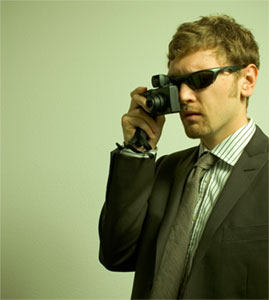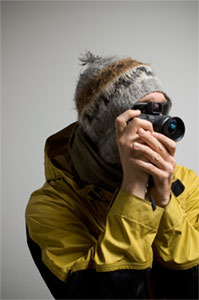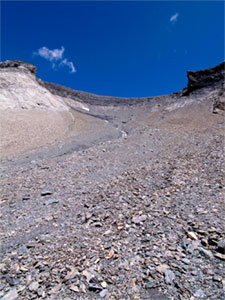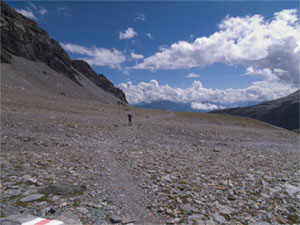
The Ricoh GRD is a point-and-shoot 8 Mega-pixel digital camera with a fixed 28 mm and 21 mm add-on lens (from a 35 mm camera focal length prespective). I’d been salivating after the GRD since it was released two years ago. Like every digital camera, it’s value has dropped after being around so long, and with the release of the Ricoh GX100 and forth coming Ricoh GRD2, the price of the GRD Creative set has become very attractive here in Switzerland.
My motivations for getting the GRD were image quality, size/weight and wide angle lens capability. After years of hauling various cameras through Europe and around the mountains of Bolivia, Colordao, New Mexico, and Switzerland I’ve come to asess the usability of a camera in relation to how much volume it takes up and how much it weighs as compared with the quality of the resulting photos. The trade-off between performance and weight or volume is critical for travel and mountaineering. I bought the Ricoh GRD because it offers high image quality with a wide angle lens in a light weight design.

I also bought the GRD because with its macro capabilities, it opens up more options to explore. Therefore, the Ricoh GRD was pretty much a no-brainer for me. Wide angle lenses are generally harder to design and implement in any camera platform. That’s why most digital cameras have focal lengths from about 35 mm onwards. This posses a problem for a traveler/mountaineer, since the subjects, mountains and buildings are often times too close to be captured effectively using the 35 mm focal length. When balanced on a razor rock edge, there’s no possiblity of taking a few steps back to get more of that mountain in the picture frame. Hence, a wide angle lens is essential for my travels.

People tend to get lost in the Mega-pixel debate. A consumer is liable to check out the price of a Canon Rebel or Nikon D40 and not give a thought to the lenses that would really excel with those bodies. An 8 Mega-pixel point-and-shoot with a sub-par lens might be on par with a 2 Mega-pixel DSLR (like the Canon D2000) simply because of the lense quality difference between the two cameras.
So it really makes sense to design a camera and lens together, which is basically what one has with the Ricoh GRD. The lens is tack sharp as can be, and the image quality with the 28 mm or 21 mm lenses is just outstanding. But no lens-sensor combination is worth anything without kick-ass user control. The Ricoh GRD and GX100 are the only point-and-shoots with full manual control. Yes there’s the Fujis and Leicas/Panasonics which claim full manual, but they don’t have adjustment wheels, you have to do it via menus. The Canon G7 and G9 come close, but you only have one control wheel. Plus, and this is huge, the Ricoh GRD has the Raw image format.
Now, it does suck that the time required to write a Raw file on the GRD is a tad long, on the order of 10-15 seconds. Amateur camera critics and professional equipment complainers throughout the internet have decreed the long Raw write time as a "deal breaker" meaning that they’ll feel entitled to not buy the camera and then waste a great deal of their day complaining about the GRD instead of taking photos in the real world. The Raw write time is an issue, but it hasn’t been an obstacle for me.

The GRD has no built-in viewfinder. But an external high-quality finder fits into the hotshoe. I love this combination because it allows me to get the exposure right by monitoring the historgram on the LCD screen and then composing using the viewfinder for excellent framing and stabilization. The viewfinder is bright and works great with eyeglasses, sunglasses, or no glasses. In a sense, the GRD actually exceeds the capabilities of my DSLRs because I get exposure information in realtime (via the live historgram) and only need to take one image. With a DSLR I have to take an image and then review the historgram (chimp the image), then retake the shot if the exposure was off. It doesn’t matter if your DSLR can take multiple Raw images per second if the exposure isn’t correct. So, for a landscape shot, I actually waste more time getting the exposure right with a DSLR than with the 10-15 seconds Raw writing time with the GRD. Hence, the long Raw write time is a non-issue with me. Now, it’s true that the new crop of DSLRs have live-view, so one can get the exposure right the first time, but it will be a while before I pick one up.

So far the Ricoh GRD has been along on trips through Zurich, the Alps, and now Tokyo. I love the GRD, I love the image quality, I love the manual control, and I love how easy it is to use. When you buy a Ricoh, you’re also supporting the camera design efforts of a company which actually listens to it’s users. Ricoh cameras like the GRD and GX100 will include a number of firmware updates. Some will say this is proof that the camera was released too soon, and should have gone through more testing before release. I see it as Ricoh listening to their customers and providing support to improve the funtionality of their product after the sale. Ricoh is one of the most foreward looking and innovative camera makers today, and I like the idea of supporting them. If you’re looking for a take everywhere high-quality camera with wide angle lens, manual control, and Raw image capabilities, the GRD might be for you. The GRD is stealthy and robust. It can go dressed up in the city or rugged into the mountains and continually retain its cool factor.

Hi!!! I’ve read this twice and am trying to come up with something intelligent, witty, or just plain applicable to say. Alas, I’m not sure if I have any idea what you are talking about. Anyway, we await some awesome shots from Japan. Our walls are bare, so fill them up. I know you love the mountains, but slip in some market/food ones, plllllllllllease.
Yes, I plan on covering Tokyo as well, I’m just getting over jet lag at the moment. Actually I have some cool shots from an Okinawa restaurant, but it’s all raw and whole-fried fish. But, ah, what was confusing about the post?
Awesome review Mark. I’ve been pining for a GR-D or something like it for a while as well. I shot with a film based Ricoh GR for several years. It was the ultimate mountaineering camera. I took it 20,320 ft. on Denali twice and it functioned flawlessly. Now I’m just wondering if the GR-D is the best bet (faster fixed focul length lens-probably better image qualitiy) or the GX100 (with zoom capability. Either way, I’m blown away with all of the features that they crammed into these little pocket cameras. My SLR may begin collecting dust if I can get my hands on one!
Matt,
I’m glad you found it useful. I should have a write up on the mountain tour I did with the GRD in the next weeks or so. I’ve seen a couple of film GRs here at used shops in Tokyo and am tempted to pick one up, ahh, but I have to many toys as it is.
At this specific point in time I would have to recommend the GX100 over the GRD, unless you find the GRD at a really cheap price (www.rioch.bz) like I did, which was my main reason for buying the GRD. Unless you need one today though (like I did), I would wait a little while.
The next GRD model will probably be announced in the next few months (according to rumors on the net) and there’s no doubt that it will improve upon the current drawbacks of the GRD: slow Raw write speed, noise at higher ISOs, and it will probably have an anti-shake system like the GX100 sports.
There’s also the Sigma DP1 (APS sized sensor) that is still in development (according to Sigma) but even if it is ever released, I think the cost for it will be too high (probably arouond 1000 USD).
Salut,
j’ai un RICOH GRD depuis un an et demi et je suis toujours très fan de cet appareil vraiment étonnant. Mes photos au GRD:
http://ricoh-grd.blogspot.com/
@+
THis is a great post. I have been looking to upgrade my camera and this is by far the best review of a camera I have seen. I look forward to seeing your pictures from your trip..
I am going to bookmark and return to see more great post
This seems to be a good camera but I dont like how it looks like. It looks like the old cameras those days, bulky and big. 🙁